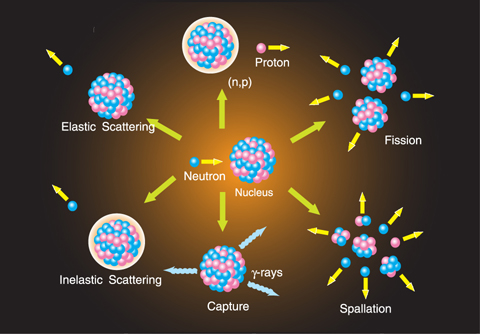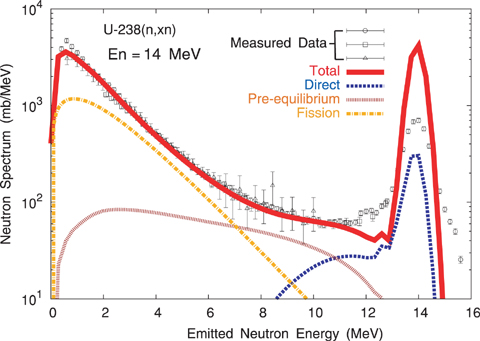
Fig.7-3 Types of nuclear reactions

Fig.7-4 Comparison of calculated and measured neutron spectra
Reactor designs, shielding analyses, and safety evaluations of criticality etc. need precise prediction of neutron behavior. The neutron behavior is determined by nuclear reactions (Fig.7-3) of the nuclei which make up the materials used. The probability of a nuclear reaction is determined by nuclear cross section. The data related to nuclear reactions like cross section are called nuclear reaction data. Reliable nuclear reaction data are indispensable for accurate reactor design and other applications. The nuclear reaction data and other data such as half-lives of radioactive nuclides are broadly called nuclear data, and they are the basis for planning nuclear applications. Neutron reaction data are especially important for reactor applications. Reliable reactor designs and safety analyses depend on the reliability of the basic nuclear data used.
Activities to provide reliable nuclear reaction data have continued from the early days of nuclear development. The nuclear reaction data are based on theoretical models and measurements, and they are required to cover neutrons in the energy range from thermal (0.025 eV) to high energy produced by fission (~10 MeV) in their effects on all used materials to understand the neutron behavior in a reactor. The number of naturally occurring stable isotopes which make up materials amounts to over 220 and the measurement of these over the full energy region is difficult. The measured data and the theoretical models are appropriately combined to provide all the needed nuclear reaction data. As there is no single theoretical model applicable to this wide energy region, various kinds of nuclear models have to be used to predict the nuclear reactions. This procedure requires much effort to keep consistency among the model calculations.
We have developed a comprehensive code for nuclear data evaluation, CCONE, which maintains this consistency. As the code uses an object-oriented programming language, it is easy to calculate the neutron and γ-ray spectra emitted by complicated reactions producing many nuclei by dynamically treating them as objects. The code has been tested for the nuclear data of thorium, uranium and plutonium isotopes and its accuracy has been confirmed. Fig.7-4 shows the energy spectrum of neutrons emitted after impinging on uranium-238. Although the spectrum consists of many nuclear reaction processes (direct, pre-equilibrium, fission processes; the total spectrum is their composite), the calculation by CCONE agrees well with the measured data. This code is to be used for future nuclear data evaluation to provide reliable nuclear reaction data. The development of CCONE was honored with a Special Award and Award for Distinguished Technology by the Atomic Energy Society of Japan in March, 2008.
<Previous: 7 Nuclear Science and Engineering Research | Next: 7-2 >